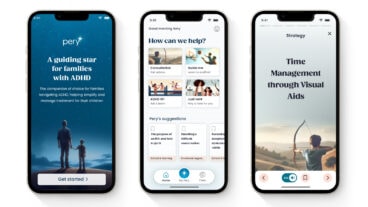‘This is the first time you can assess an image of an asthma attack and the efficacy of drug treatment in real time’ – Igal Kushnir.
(Originally published October 29, 2006)
Dr. Igal Kushnir, the founder and CEO of Deep Breeze Medical Diagnosis, directed me towards the clinical data page on the company’s web site. “There,” he said as I opened a link to asthma. “That’s the first ever image of what an asthma attack looks like in the lungs.”
There were two animated pictures on the page, one showing the breathing pattern of a 19-year-old girl who was suffering an asthma attack; the second of her breathing pattern after treatment with bronchodilation. In the first, the air – which appears gray and black in the image – was moving unevenly, unable to completely fill the lungs. Red dots indicated wheezing. In the second, the girl’s lungs were reacting better, bringing air more smoothly and filling the lungs more completely without wheezing.
“This is revolutionary,” Kushnir said, as I watched the lungs in the first image breathe painfully in and out. “This is the first time you can assess an image of an asthma attack and the efficacy of drug treatment in real time. You can see whether a drug is having an impact and watch as it improves breathing.”
The technology, called Vibration Response Imaging (VRI), is not only confined to asthma, as links to images of pleural effusion, emphysema, and lung transplants on the same page confirm. This is a new non-invasive pulmonary imaging technology designed to help clinicians diagnose, assess and treat various respiratory conditions.
It is a huge potential market. “Seventy percent of patients who go to a GP have some kind of complaint about their respiratory tract, whether its flu, bronchitis, asthma, or poor breathing,” Kushnir, a practicing pediatrician, told ISRAEL21c. In the US, some 20 million people suffer from asthma alone (6.2m. are children), leading to an annual health care cost of some $16.1 billion.
Kushnir’s excitement is clear. He believes that VRI is potentially one of the biggest medical breakthroughs since the development of the ultrasound. “This is the first completely novel medical technology in the world in the last 30 years,” he explains. “Every new and exciting health technology we see today, whether it’s an MRI, or a sophisticated ultrasound, is based on existing technologies. We have invented a completely new concept.”
VRI is designed to capture dynamic images which are not currently available using any other lung imaging solution. The technology registers vibration response energy generated by air flow inside the tissue of the lungs to create a real-time structural and functional image of the respiration process. Kushnir conjures up the image of earthquake to explain.
“In an earthquake everything in your room vibrates at its own specific vibration frequency, according to the structure of the object, its elasticity, and liquid content. If I place sensors on the wall, I can collect all the gibberish of these individual vibrations and recreate from them every item in the room, whether it’s a table or a chair, or a person. With VRI, we use a patient’s back as the wall. As air flows through the bronchial tube it flows in a turbulent way, creating a vibration in the bronchial tube. This propagates in the lung tissue and eventually arrives at the skin.”
To pick up these vibrations, Deep Breeze has developed an array of pressure sensors which can be attached painlessly to a patient’s back. These pick up the lung tissue vibrations, collect the information, and send it on to a computer which then generates an image of the air flow into the lung.
According to Kushnir, every disease has its own imprint, enabling a doctor to diagnose all the different respiratory pathologies. The company’s flagship product is the VRIxp, which is already on sale in Europe, and will go on sale in the US in the spring. The device is non-invasive and radiation free.
Unlike competing solutions – X-rays, ultrasound or MRI (magnetic resonance imaging) – it uses passive vibration energy that is naturally created within the body’s organs to produce a dynamic image of the organ.
The test takes less than five minutes. Patients take a few breaths and the procedure is over. Real-time images appear on a computer screen and can be automatically compared to any previous images taken before. There is no limit to the number of tests that can be carried out, allowing a doctor to follow and assess a patient’s recovery. Operators can be trained in half an hour, enabling nurses or technicians to carry out the tests.
For doctors, this technology holds the promise of a vital new assessment tool.
Over the last 200 years, one of the only means of assessing the health of a patient’s lungs was through a stethoscope. This technology has hardly changed in 200 years, and most GPs rely on this, their eyes, their memory and intelligence to form a diagnosis. In hospitals and clinics, X-rays, ultrasound, and MRI are also used to assess respiratory health, but these offer only limited information, according to Kushnir.
“Now we have a device that offers the physician an enormous amount of objective, accurate information, which extends far beyond that offered by traditional means,” says Kushnir. “The VRIxp images expand a physician’s understanding of the condition of the lungs hence improving patient management and outcome. They also allow the physician to assess breathing capacity before and after treatment which is a complete novelty. This enables the doctor to judge when is the best time to disconnect a patient from a ventilator for example, which can save thousands of dollars.”
This is not Kushnir’s first foray into business. In 1998, he founded MTRE Advanced Technologies, a medical start-up that developed a body thermoregulation device invented by Kushnir. In August this year, MTRE signed an estimated $10m. contract with US company, Premier Inc., which sells goods to 1,500 US hospitals. Kushnir left MTRE in 2001 and a day later, the 59-year-old set up Deep Breeze with his son, Alon, who is now the company’s VP of regulatory and medical affairs. Today Deep Breeze employs 50 and is headquartered in Or Akiva.
Deep Breeze received seed money of $1m. from Nisko Industries, a publicly traded company on the Tel Aviv Stock Exchange. Shortly afterwards, Vitalife Life Sciences Fund invested several million dollars in the start-up and also brought US investor, SCP, a $1 billion venture capital company, to invest several million dollars more.
Altogether about $10m. has been invested in Deep Breeze. The original investors invest more capital whenever necessary. “They don’t want to bring in new investors,” says Kushnir.
Deep Breeze has held clinical trials of its technology across Europe, Israel and the US.
Deep Breeze began selling the VRIxp system in Europe in 2006, launching the product at the European Respiratory Society meeting in Denmark after it received CE approval. Interest was high and the company even sold units at the convention itself. Today the company is selling to Germany, England, Spain and Italy. First deliveries are expected in the last quarter of this year.
Initially, Deep Breeze plans to sell its products mainly to medical institutes, hospitals and ICUs. Later it will adjust the product for sale to doctors and clinics where Kushnir believes it will have enormous impact. Finally it plans to move into the private home user market. “If we can install this technology in every GPs office, it will drastically improve their ability to make a diagnosis,” predicts Kushnir.
Once sales of the VRIxp are established, Deep Breeze plans to begin exploring other new areas. The VRI technology can be applied to virtually every organ of the body, including the heart, and the company has already begun R&D in this huge and lucrative area.
Aside from the traditional diagnostic tools, Kushnir insists there is no alternative competing technology. “This is totally new,” he says. He is aware, however, that rivals will emerge soon, but he remains unconcerned. “If it’s a good technology then people will imitate us. If we don’t have copy cats, then it means we are worth nothing.”
Heavy patent protection of 14 patents also helps to keep Kushnir unruffled.
In the meantime, some large multinational players have already shown an interest in Deep Breeze, according to Kushnir. “We are in negotiations,” he explains. “Someone may buy us. It’s a very open option.”
Despite this, the company is still forging ahead with its main goal – to go public on Nasdaq sometime next year. This is a very ambitious move for such a small, unproven company, but Kushnir thinks this early move to the market is completely justified.
“This is a realistic option,” he insists. “We have already started the process. This is not your usual story of a nice company with one product. It’s a much bigger story than that. We have a completely novel technology with enormous potential, not just for the pulmonology market but also for cardiology. This is exciting and new. There has been nothing this big since ultrasound.”
(See Exclusive video report on DeepBreeze from IsraelHighTech.TV).













